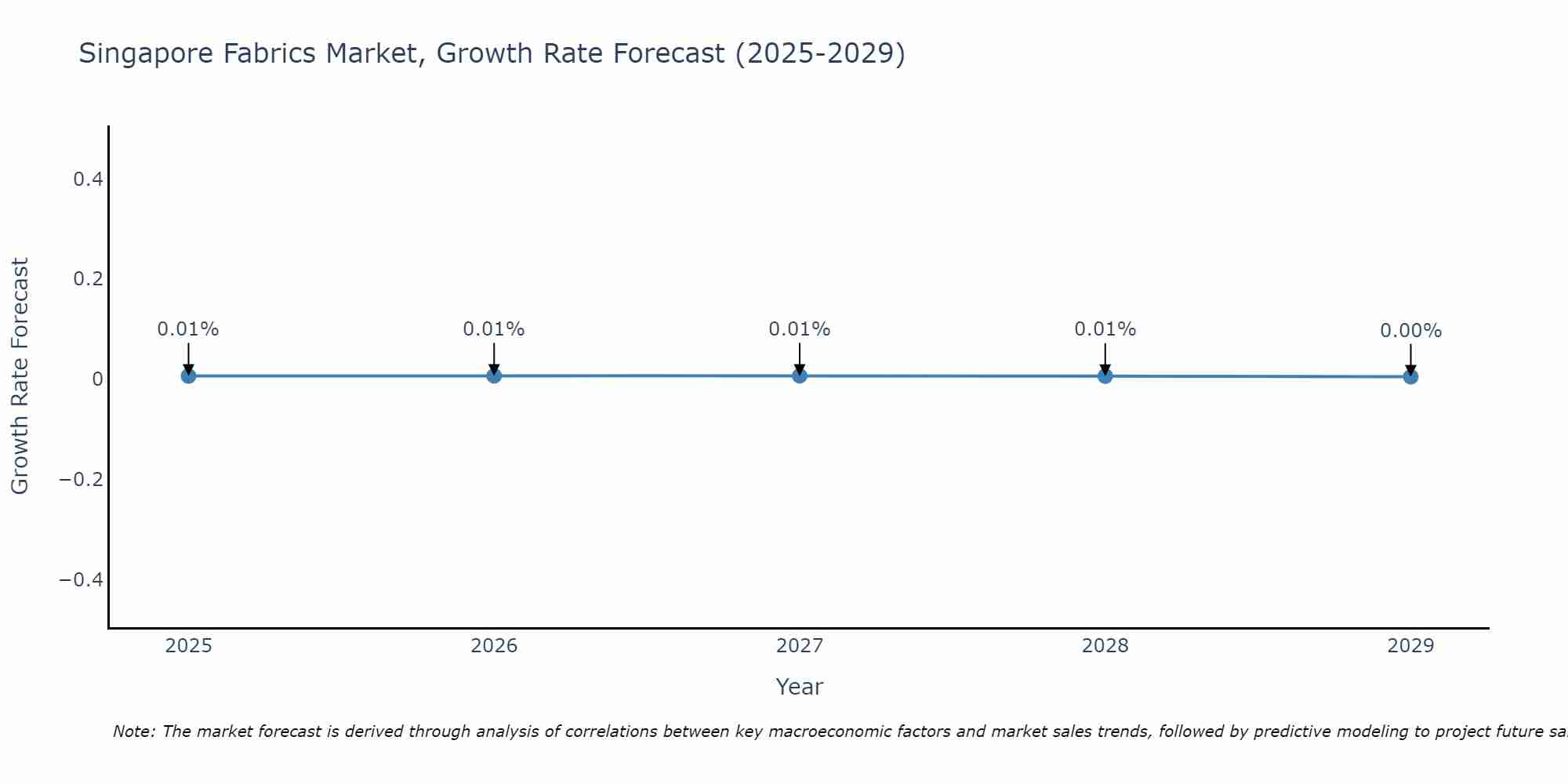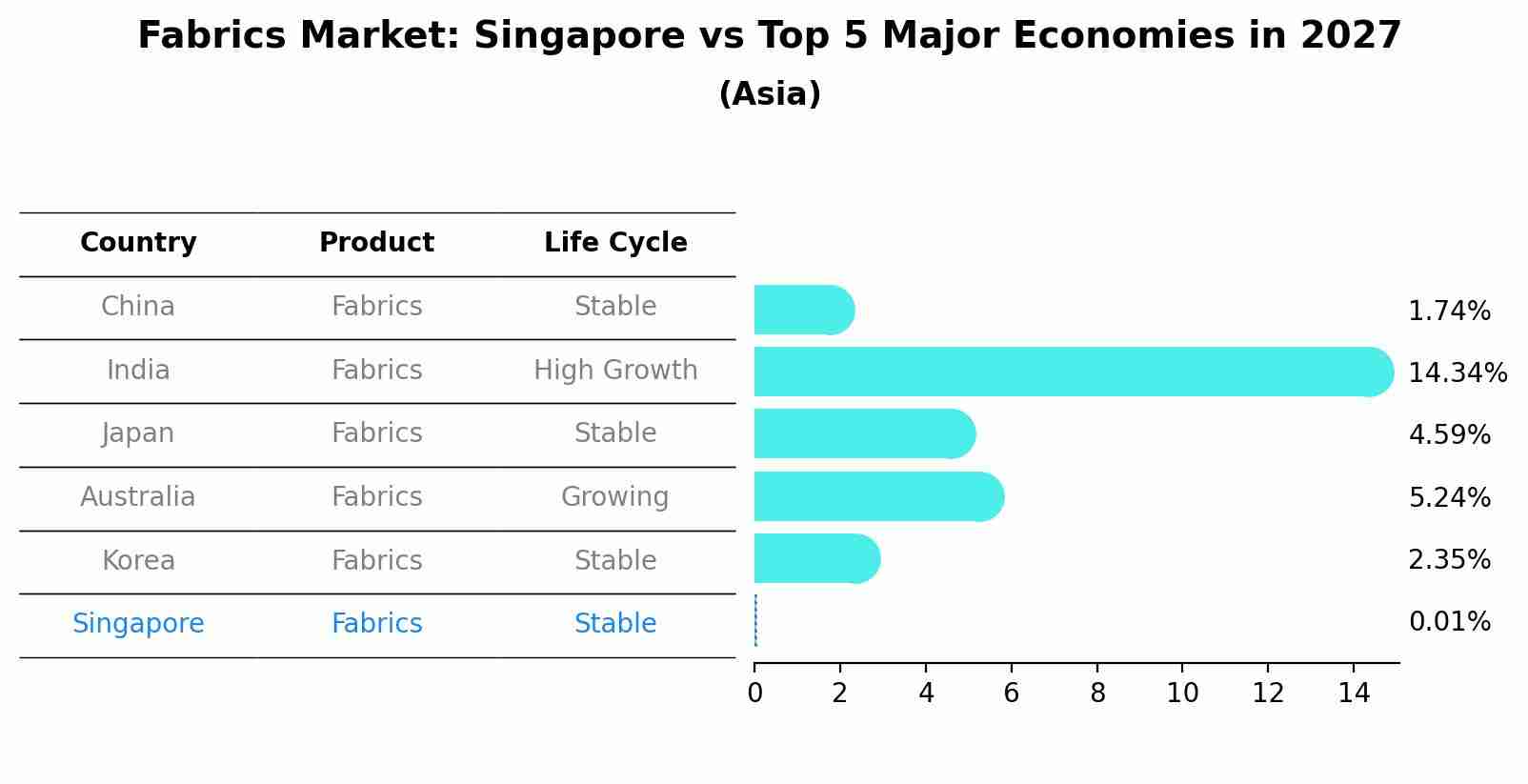Singapore Fabrics Market (2024-2030) | Revenue, Forecast, Companies, Analysis, Value, Trends, Growth, Outlook, Share, Size & Industry
| Product Code: ETC023627 | Publication Date: Jul 2023 | Updated Date: Apr 2025 | Product Type: Report | |
| Publisher: 6Wresearch | Author: Ravi Bhandari | No. of Pages: 70 | No. of Figures: 35 | No. of Tables: 5 |
Singapore Fabrics Market Size Growth Rate
The Singapore Fabrics Market is projected to witness mixed growth rate patterns during 2025 to 2029. Growth accelerates to 0.01% in 2027, following an initial rate of 0.01%, before easing to 0.00% at the end of the period.

Fabrics Market: Singapore vs Top 5 Major Economies in 2027 (Asia)
By 2027, the Fabrics market in Singapore is anticipated to reach a growth rate of 0.01%, as part of an increasingly competitive Asia region, where China remains at the forefront, supported by India, Japan, Australia and South Korea, driving innovations and market adoption across sectors.

Singapore Fabrics Market Synopsis
The Singapore fabrics market is expected to grow at a CAGR of 4.8% over the forecast period (2020-2026). The country???s growth potential in textiles and clothing industry, increasing demand for eco-friendly fabrics, rise in disposable income as well as investment from leading players are some of the major factors driving market growth. Additionally, technological advancements such as digital printing and 3D knitting technology are likely to further fuel the demand for fabrics over the forecast period.
Market Drivers
Growth Potentialin Textile and Clothing Industry: Singapore is one of the world`s largest textile exporters with more than 50 percent of exports going to Europe, North America and Asia Pacific countries. Growing population coupled with rising consumer spending on apparel products is anticipated to spur fabric demand in Singapore over the next few years. Moreover, government initiatives such as grants & incentives for setting up production facilities are also likely to contribute significantly towards revenue generation from this sector during 2020???2026.Increasing Demandfor Eco-Friendly Fabrics: Consumers??? preference towards environmental friendly solutions has been growing due to concern regarding pollution levels globally which will result into an increase in adoption of sustainable fabrics including organic cotton or bamboo fibers among others which will drive market growth through 2026.
Market challenges
High initial set up cost required due high capital expenditure associated with production processes along with stringent regulations related health & safety issues by local governing bodies can impede market growth during 2020???2026.Fluctuations in raw material prices like cotton & synthetic fibers may hinder overall profitability margins resulting into decrease revenues generated by manufacturers operating within this industry space throughout 2020???2027.
Key players
Major companies operating within global fabric markets include China National Textile Corporation (CNTC), Indorama Ventures PCL., Reliance Industries Ltd., Aditya Birla Group, Lenzing AG, Huvis Corporation.
Covid-19 Impact
Due to various lockdowns that have been implemented across countries owing pandemic situation since Q1 ???2020, business operations across industries have come standstill resulting into significant slowdown economic activities around globe including Singapore affecting sales related metrics negatively impacting global fabric markets severely by lowering revenues generated worldwide through 2021.
Key Highlights of the Report:
- Singapore Fabrics Market Outlook
- Market Size of Singapore Fabrics Market, 2023
- Forecast of Singapore Fabrics Market, 2030
- Historical Data and Forecast of Singapore Fabrics Revenues & Volume for the Period 2020-2030
- Singapore Fabrics Market Trend Evolution
- Singapore Fabrics Market Drivers and Challenges
- Singapore Fabrics Price Trends
- Singapore Fabrics Porter's Five Forces
- Singapore Fabrics Industry Life Cycle
- Historical Data and Forecast of Singapore Fabrics Market Revenues & Volume By Types for the Period 2020-2030
- Historical Data and Forecast of Singapore Fabrics Market Revenues & Volume By Manmade And Special Fiber Fabrics for the Period 2020-2030
- Historical Data and Forecast of Singapore Fabrics Market Revenues & Volume By Knitted Fabrics for the Period 2020-2030
- Historical Data and Forecast of Singapore Fabrics Market Revenues & Volume By Cotton for the Period 2020-2030
- Historical Data and Forecast of Singapore Fabrics Market Revenues & Volume By Non-Cotton for the Period 2020-2030
- Historical Data and Forecast of Singapore Fabrics Market Revenues & Volume By Distribution Channel for the Period 2020-2030
- Historical Data and Forecast of Singapore Fabrics Market Revenues & Volume By Direct for the Period 2020-2030
- Historical Data and Forecast of Singapore Fabrics Market Revenues & Volume By Indirect for the Period 2020-2030
- Historical Data and Forecast of Singapore Fabrics Market Revenues & Volume By Hypermarket/Supermarket for the Period 2020-2030
- Historical Data and Forecast of Singapore Fabrics Market Revenues & Volume By Specialty Stores for the Period 2020-2030
- Historical Data and Forecast of Singapore Fabrics Market Revenues & Volume By Online Store for the Period 2020-2030
- Singapore Fabrics Import Export Trade Statistics
- Market Opportunity Assessment By Types
- Market Opportunity Assessment By Distribution Channel
- Singapore Fabrics Top Companies Market Share
- Singapore Fabrics Competitive Benchmarking By Technical and Operational Parameters
- Singapore Fabrics Company Profiles
- Singapore Fabrics Key Strategic Recommendations
Frequently Asked Questions About the Market Study (FAQs):
1 Executive Summary |
2 Introduction |
2.1 Key Highlights of the Report |
2.2 Report Description |
2.3 Market Scope & Segmentation |
2.4 Research Methodology |
2.5 Assumptions |
3 Singapore Fabrics Market Overview |
3.1 Singapore Country Macro Economic Indicators |
3.2 Singapore Fabrics Market Revenues & Volume, 2020 & 2030F |
3.3 Singapore Fabrics Market - Industry Life Cycle |
3.4 Singapore Fabrics Market - Porter's Five Forces |
3.5 Singapore Fabrics Market Revenues & Volume Share, By Types, 2020 & 2030F |
3.6 Singapore Fabrics Market Revenues & Volume Share, By Distribution Channel, 2020 & 2030F |
4 Singapore Fabrics Market Dynamics |
4.1 Impact Analysis |
4.2 Market Drivers |
4.3 Market Restraints |
5 Singapore Fabrics Market Trends |
6 Singapore Fabrics Market, By Types |
6.1 Singapore Fabrics Market, By Types |
6.1.1 Overview and Analysis |
6.1.2 Singapore Fabrics Market Revenues & Volume, By Types, 2020-2030F |
6.1.3 Singapore Fabrics Market Revenues & Volume, By Manmade And Special Fiber Fabrics, 2020-2030F |
6.1.4 Singapore Fabrics Market Revenues & Volume, By Knitted Fabrics, 2020-2030F |
6.1.5 Singapore Fabrics Market Revenues & Volume, By Cotton, 2020-2030F |
6.1.6 Singapore Fabrics Market Revenues & Volume, By Non-Cotton, 2020-2030F |
6.2 Singapore Fabrics Market, By Distribution Channel |
6.2.1 Overview and Analysis |
6.2.2 Singapore Fabrics Market Revenues & Volume, By Direct, 2020-2030F |
6.2.3 Singapore Fabrics Market Revenues & Volume, By Indirect, 2020-2030F |
6.2.4 Singapore Fabrics Market Revenues & Volume, By Hypermarket/Supermarket, 2020-2030F |
6.2.5 Singapore Fabrics Market Revenues & Volume, By Specialty Stores, 2020-2030F |
6.2.6 Singapore Fabrics Market Revenues & Volume, By Online Store, 2020-2030F |
7 Singapore Fabrics Market Import-Export Trade Statistics |
7.1 Singapore Fabrics Market Export to Major Countries |
7.2 Singapore Fabrics Market Imports from Major Countries |
8 Singapore Fabrics Market Key Performance Indicators |
9 Singapore Fabrics Market - Opportunity Assessment |
9.1 Singapore Fabrics Market Opportunity Assessment, By Types, 2020 & 2030F |
9.2 Singapore Fabrics Market Opportunity Assessment, By Distribution Channel, 2020 & 2030F |
10 Singapore Fabrics Market - Competitive Landscape |
10.1 Singapore Fabrics Market Revenue Share, By Companies, 2023 |
10.2 Singapore Fabrics Market Competitive Benchmarking, By Operating and Technical Parameters |
11 Company Profiles |
12 Recommendations |
13 Disclaimer |
- Single User License$ 1,995
- Department License$ 2,400
- Site License$ 3,120
- Global License$ 3,795
Search
Thought Leadership and Analyst Meet
Our Clients
Related Reports
- Afghanistan Apparel Market (2026-2032) | Growth, Outlook, Industry, Segmentation, Forecast, Size, Companies, Trends, Value, Share, Analysis & Revenue
- Canada Oil and Gas Market (2026-2032) | Share, Segmentation, Value, Industry, Trends, Forecast, Analysis, Size & Revenue, Growth, Competitive Landscape, Outlook, Companies
- Germany Breakfast Food Market (2026-2032) | Industry, Share, Growth, Size, Companies, Value, Analysis, Revenue, Trends, Forecast & Outlook
- Australia Briquette Market (2025-2031) | Growth, Size, Revenue, Forecast, Analysis, Trends, Value, Share, Industry & Companies
- Vietnam System Integrator Market (2025-2031) | Size, Companies, Analysis, Industry, Value, Forecast, Growth, Trends, Revenue & Share
- ASEAN and Thailand Brain Health Supplements Market (2025-2031) | Strategy, Consumer Insights, Analysis, Investment Trends, Opportunities, Growth, Size, Share, Industry, Revenue, Segments, Value, Segmentation, Supply, Forecast, Restraints, Outlook, Competition, Drivers, Trends, Demand, Pricing Analysis, Competitive, Strategic Insights, Companies, Challenges
- ASEAN Bearings Market (2025-2031) | Strategy, Consumer Insights, Analysis, Investment Trends, Opportunities, Growth, Size, Share, Industry, Revenue, Segments, Value, Segmentation, Supply, Forecast, Restraints, Outlook, Competition, Drivers, Trends, Demand, Pricing Analysis, Competitive, Strategic Insights, Companies, Challenges
- Europe Flooring Market (2025-2031) | Outlook, Share, Industry, Trends, Forecast, Companies, Revenue, Size, Analysis, Growth & Value
- Saudi Arabia Manlift Market (2025-2031) | Outlook, Size, Growth, Trends, Companies, Industry, Revenue, Value, Share, Forecast & Analysis
- Uganda Excavator, Crane, and Wheel Loaders Market (2025-2031) | Strategy, Consumer Insights, Analysis, Investment Trends, Opportunities, Growth, Size, Share, Industry, Revenue, Segments, Value, Segmentation, Supply, Forecast, Restraints, Outlook, Competition, Drivers, Trends, Demand, Pricing Analysis, Competitive, Strategic Insights, Companies, Challenges
Industry Events and Analyst Meet
Whitepaper
- Middle East & Africa Commercial Security Market Click here to view more.
- Middle East & Africa Fire Safety Systems & Equipment Market Click here to view more.
- GCC Drone Market Click here to view more.
- Middle East Lighting Fixture Market Click here to view more.
- GCC Physical & Perimeter Security Market Click here to view more.
6WResearch In News
- Doha a strategic location for EV manufacturing hub: IPA Qatar
- Demand for luxury TVs surging in the GCC, says Samsung
- Empowering Growth: The Thriving Journey of Bangladesh’s Cable Industry
- Demand for luxury TVs surging in the GCC, says Samsung
- Video call with a traditional healer? Once unthinkable, it’s now common in South Africa
- Intelligent Buildings To Smooth GCC’s Path To Net Zero


















